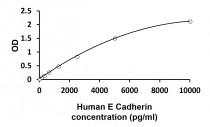ARG81680
Human E Cadherin ELISA Kit
Human E Cadherin ELISA Kit for ELISA and Human
Component
| Cat No | Component Name | Package | Temp |
|---|---|---|---|
| ARG81680-001 | Antibody-coated microplate | 8 X 12 strips | 4°C. Unused strips should be sealed tightly in the air-tight pouch. |
| ARG81680-002 | Standard | 2 X 10 ng/vial | 4°C |
| ARG81680-003 | Standard/Sample diluent | 30 ml (Ready to use) | 4°C |
| ARG81680-004 | Antibody conjugate concentrate (100X) | 1 vial (100 µl) | 4°C |
| ARG81680-005 | Antibody diluent buffer | 12 ml (Ready to use) | 4°C |
| ARG81680-006 | HRP-Streptavidin concentrate (100X) | 1 vial (100 µl) | 4°C |
| ARG81680-007 | HRP-Streptavidin diluent buffer | 12 ml (Ready to use) | 4°C |
| ARG81680-008 | 25X Wash buffer | 20 ml | 4°C |
| ARG81680-009 | TMB substrate | 10 ml (Ready to use) | 4°C (Protect from light) |
| ARG81680-010 | STOP solution | 10 ml (Ready to use) | 4°C |
| ARG81680-011 | Plate sealer | 4 strips | Room temperature |
Overview
| Product Description | ARG81680 Human E Cadherin ELISA Kit is an Enzyme Immunoassay kit for the quantification of Human E Cadherin in serum, plasma (heparin), saliva, urine and cell culture supernatants. |
|---|---|
| Tested Reactivity | Hu |
| Tested Application | ELISA |
| Specificity | There is no detectable cross-reactivity with other relevant proteins. |
| Target Name | E Cadherin |
| Conjugation | HRP |
| Conjugation Note | Substrate: TMB and read at 450 nm. |
| Sensitivity | 78 pg/ml |
| Sample Type | Serum, plasma (heparin), saliva, urine and cell culture supernatants. |
| Standard Range | 156 - 10000 pg/ml |
| Sample Volume | 100 µl |
| Precision | Intra-Assay CV: 5.7%; Inter-Assay CV: 6.1% |
| Alternate Names | Uvomorulin; Arc-1; Cadherin-1; E-cadherin; CDHE; CD antigen CD324; ECAD; CAM 120/80; LCAM; Epithelial cadherin; UVO; CD324 |
Application Instructions
| Assay Time | ~ 5 hours |
|---|
Properties
| Form | 96 well |
|---|---|
| Storage Instruction | Store the kit at 2-8°C. Keep microplate wells sealed in a dry bag with desiccants. Do not expose test reagents to heat, sun or strong light during storage and usage. Please refer to the product user manual for detail temperatures of the components. |
| Note | For laboratory research only, not for drug, diagnostic or other use. |
Bioinformation
| Database Links | |
|---|---|
| Gene Symbol | CDH1 |
| Gene Full Name | cadherin 1, type 1 |
| Background | E Cadherin is a classical cadherin of the cadherin superfamily. Alternative splicing results in multiple transcript variants, at least one of which encodes a preproprotein that is proteolytically processed to generate the mature glycoprotein. This calcium-dependent cell-cell adhesion protein is comprised of five extracellular cadherin repeats, a transmembrane region and a highly conserved cytoplasmic tail. Mutations in this gene are correlated with gastric, breast, colorectal, thyroid and ovarian cancer. Loss of function of this gene is thought to contribute to cancer progression by increasing proliferation, invasion, and/or metastasis. The ectodomain of this protein mediates bacterial adhesion to mammalian cells and the cytoplasmic domain is required for internalization. This gene is present in a gene cluster with other members of the cadherin family on chromosome 16. [provided by RefSeq, Nov 2015] |
| Function | Cadherins are calcium-dependent cell adhesion proteins (PubMed:11976333). They preferentially interact with themselves in a homophilic manner in connecting cells; cadherins may thus contribute to the sorting of heterogeneous cell types. CDH1 is involved in mechanisms regulating cell-cell adhesions, mobility and proliferation of epithelial cells (PubMed:11976333). Has a potent invasive suppressor role. It is a ligand for integrin alpha-E/beta-7. E-Cad/CTF2 promotes non-amyloidogenic degradation of Abeta precursors. Has a strong inhibitory effect on APP C99 and C83 production. (Microbial infection) Serves as a receptor for Listeria monocytogenes; internalin A (InlA) binds to this protein and promotes uptake of the bacteria. [UniProt] |
| Highlight | Related products: Cadherin antibodies; Cadherin ELISA Kits; Cadherin Duos / Panels; New ELISA data calculation tool: Simplify the ELISA analysis by GainData |
| PTM | During apoptosis or with calcium influx, cleaved by a membrane-bound metalloproteinase (ADAM10), PS1/gamma-secretase and caspase-3 to produce fragments of about 38 kDa (E-CAD/CTF1), 33 kDa (E-CAD/CTF2) and 29 kDa (E-CAD/CTF3), respectively. Processing by the metalloproteinase, induced by calcium influx, causes disruption of cell-cell adhesion and the subsequent release of beta-catenin into the cytoplasm. The residual membrane-tethered cleavage product is rapidly degraded via an intracellular proteolytic pathway. Cleavage by caspase-3 releases the cytoplasmic tail resulting in disintegration of the actin microfilament system. The gamma-secretase-mediated cleavage promotes disassembly of adherens junctions. N-glycosylation at Asn-637 is essential for expression, folding and trafficking. Ubiquitinated by a SCF complex containing SKP2, which requires prior phosphorylation by CK1/CSNK1A1. Ubiquitinated by CBLL1/HAKAI, requires prior phosphorylation at Tyr-754. [UniProt] |
Images (1) Click the Picture to Zoom In
| Title | Download Link |
|---|---|
| ARG81680 Human E Cadherin ELISA Kit User manual |
 Download Download
|






